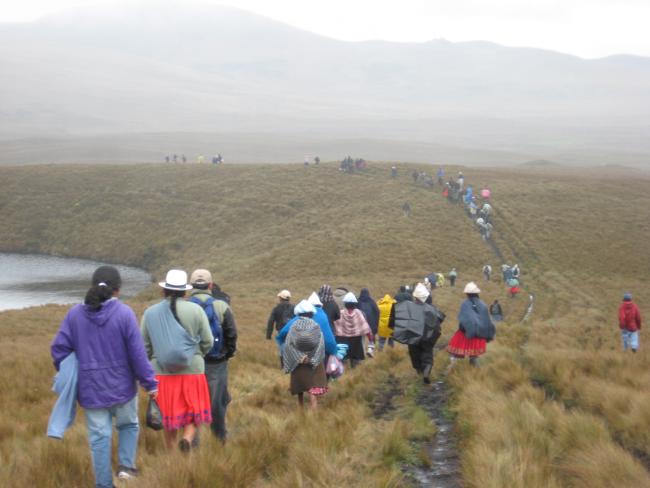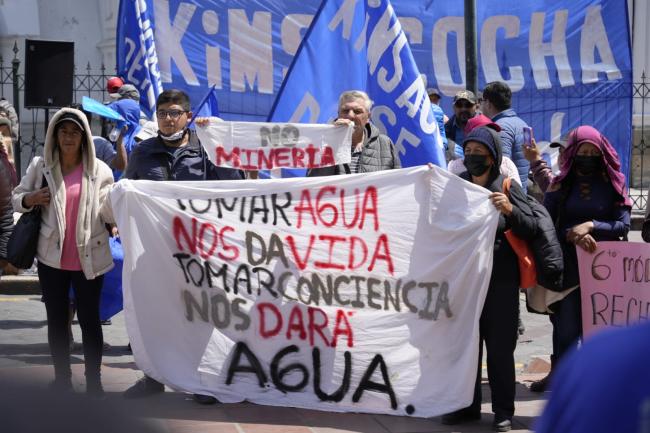
Leer este artículo en español.
The plaintiffs in the case—the Escaleras community, the Federation of Indigenous and Campesino Organizations (FOA), and the Board of Potable Water Administrators of Victoria del Portete Tarqui (JAAPE)—celebrated the decision. “This is a triumph of our 30 years of struggle that our compañeras and compañeros from Tarqui and Victoria del Portete have sustained,” said activist Ana Hernandez in a press conference on August 28, the day the ruling was announced. “Today it is declared that our struggle has not been in vain.”
The Provincial Court of Azuay ruled the defendant in the case, the Ministry of Environment, Water, and Ecological Transition (MAATE), failed to consult Indigenous communities during the advanced exploration phase. The ruling widens a lower court ruling by ordering an additional environmental consultation for non-Indigenous people, and concludes that the MAATE violated constitutionally protected rights to water and rights of nature.
“A Ticking Time Bomb”
Known locally as Kimsacocha, the project site is situated in a high altitude paramo southwest of the city of Cuenca that stores, captures, and regulates water supplies for thousands of downstream rural and urban residents. Found in several Andean countries, paramos act as a carbon sink critical for counteracting carbon emissions while also supporting a range of plant and animal life, including the Andean condor and the spectacled bear. DPM was seeking an environmental permit to begin exploitation of the Loma Larga mine project located at the headwaters of the Irquis River, from which members of the JAAPE and the Escaleras community directly draw their water supplies. The ruling bars MAATE from issuing such permits in the short term.
The ruling is significant for activists across the country resisting the expansion of oil and mining in their watersheds and territories. Comunidad Escaleras resident Ruth Pugo expressed relief: “I think the court made a good decision because we have been fighting in defense of water and we are right [to do so]. We have spent a lot of time in the streets [protesting] and they took us into account.”
The proposed 2.2 million ounce gold mine, in addition to copper and silver extraction, is a subterranean mine that would move approximately 3,000 tons of earth a day in this fragile ecosystem and leave behind 5.5 million tons of waste over the proposed 12 years of operation. A report by the Colombian group TERRAE called the project a “ticking time bomb” for its likelihood of permanently contaminating the water supplies of surrounding urban and rural residents. Arsenic and other heavy metals present in the mineralized rock would likely be exposed, causing widespread contamination through the interaction of surface and subsurface water; a point that DPM has minimized in its Environmental Impact Assessment. In 2019 the municipal water agency ETAPA reported that mining activity could contaminate the water supplies of more than 660,000 residents by 2030 and over 1 million by 2050.
Anti-mining activists in Ecuador have organized marches and national strikes to protect critical watersheds and territories from extractive industries for decades, for which they have been subjected to arrests, police violence, and a public smear campaign by former leftist president Rafael Correa. Criminalization of activists continued under the conservative neoliberal governments that followed. A 2021 report by the Alliance for Human Rights in Ecuador describes the systematic violation of the rights of 449 human rights and environmental defenders across 22 cases.
Suspension of the controversial Loma Larga mine project was emitted on the heels of an August 20 electoral victory to prohibit oil drilling in the Yasuní National Park, and a referendum in the municipal district of Quito to prohibit large-scale metal mining in the Chocó Andino, a biosphere reserve.
“Our dream has been to eradicate extractivism from the paramo,” said Lauro Sigcha, President of the FOA, at the press conference. “We are very satisfied with the judge’s ruling; it gives us hope that there is justice.” The integrity of the judicial system is surprising amid an unfolding political and security crisis that is shaking the political institutions of the country, a crisis that outgoing President Guillermo Lasso has taken advantage of to fast-track stalled mining projects.
Environmental defenders understand resistance to be an ongoing and continuous process. Lizardo Zhagui, president of the JAAPE, warned the decision doesn’t guarantee that Kimsacocha will be free from mining. “The resistance [movement] must continue. As long as minerals are in the ground, there will be someone who wants to take them out.”
Kimsacocha Free of Mining – The Long Fight
Exploration in the Kimsacocha páramo began in earnest with the arrival of the multinational giant Newmont in the 1990s. Newmont sold the project to the Toronto-based IAMGOLD Corporation in the late 1990s, at a time when a World Bank technical assistance loan sought to transform the country from a primarily “artisanal” and small-scale mineral producer to a large-scale exporter. By 2000, the country passed reforms to attract foreign investors to the nascent mining industry. In 2005, questions over the impacts of IAMGOLD’s exploratory work on the Irquis watershed prompted fierce defense among Indigenous and non-Indigenous farmers who began to organize against the company. They established a broad-based movement to defend Kimsacocha as an emblem of the Pachamama that sustains life and livelihoods.
The election of Rafael Correa in 2006 transformed the political landscape and deepened conflicts over extraction in the Kimsacocha paramo. A Constituent Assembly convened in 2007 rewrote the National Constitution in 2008. Acting as a legislative body, the Assembly also emitted a Mining Mandate that would annul mineral concessions granted without community consultation and in environmentally sensitive zones. In the name of a socialist agenda, the Correa government pursued legislative reforms to allow for high-profile projects, including Loma Larga, to move forward despite significant opposition. While the National Constitution made significant advancements in defense of nature and community rights, it also set the legal framework for the centralization of natural resources.
After staging protests every year between 2005 and 2010, Indigenous campesinos turned to citizen-organized consultas (referendums) to express their opposition to mining. In 2011, JAAPE organized a community referendum in which 92.3 percent of households voted to prohibit mining in Kimsacocha. It set the stage for legally binding mining referendums to be carried out by the National Electoral Council (CNE). In 2019, 87 percent of residents in the canton of Girón voted to prohibit mining in Kimsacocha, and in 2021, Cuencanos voted to prohibit large-scale metal mining in the recharge zones of the Tarqui (Irquis), Tomebamba, Yanuncay, and Machangara rivers, and medium scale mining in the Norcay river.

Indigenous Consultation
The right to an Indigenous consultation was a hard-fought victory in the case. The recognition of Comunidad Escaleras as a Kichwa-Kañari community was challenged by the defendants as a key component of their defense. MAATE, along with Dundee Precious Metals who joined the defense as an interested third party, claimed that plaintiffs were mestizos with no legal rights to a free, prior, and informed consultation, as articulated in the UN Declaration on the Rights of Indigenous Peoples. At a provincial court hearing on October 14, 2022, lawyers argued that campesinos were mestizos based on a set of “subjective” and “objective” criteria: they do not speak Kichwa, have no traditional dress, have a modern community organization, and have no ancestral connection to the territory in question. Defendants presented live testimony from residents who participate in Corporate Social Responsibility programs to attest that they self-identify as mestizos.
Provincial court justices affirmed Indigenous self-determination, including the right to self-identify as Indigenous. The National Council for the Development of Indigenous Peoples and Nationalities (CODENPE), a government entity, granted Escaleras legal status as an Indigenous Community in 2009 based on self-identification. Furthermore, plaintiff claims to Kimsacocha as an ancestral communal territory were corroborated by Newmont’s Environmental Impact Assessment, where it was observed that traditional communal grazing lands were being usurped by land grabbers with dubious titles. Legal recognition as an Indigenous community challenges years of deep-rooted ideology of mestizaje in the region that shapes everyday and institutionalized racism against campesinos of Indigenous descent. It also works to incorporate campesinos into the fold of a skeletal plurinational state that makes it difficult to predict if the Indigenous consultation results will be enough to definitively stop the project.
Ecuador does not have a law governing Indigenous consultation, and in its absence, decisions are often amenable to extractive activities. A 2022 Constitutional Court granted authorities the ability to approve mining activities even when Indigenous consultation results in majority opposition. Additionally, President Guillermo Lasso’s decree 754, emitted on May 31 to fast-track mining investments, weakened the environmental code pertaining to Indigenous and environmental consultation processes. Its constitutionality is challenged by the national Indigenous organization, CONAIE, in a pending protective action case that will likely have a bearing on future Indigenous consultation processes.
Legal Security
Even as the Ecuadorian Courts have emitted some rulings backing grassroots democracy, these decisions rarely challenge the primacy of extractive development.
The Ecuadorian judicial system has largely upheld the rights of mining companies to maintain legal titles to their concessions, which is encapsulated in the term seguridad jurídica. Although Cuenca’s 2021 referendum prohibiting large-scale metal mining was approved by the Constitutional Court, the ruling restricted its application to future activities. Environmental activists argued the Cuenca referendum would prohibit the Loma Larga project from advancing to the exploitation phase, while the ex-Vice Minister of Mines Fernando Benalcázar argued that consultation results could not be retroactively applied to the Loma Larga project.
A year after the referendum results, the presence of work crews at the Loma Larga mine site prompted protective action measures in a lower court that ultimately led to last month’s provincial court ruling.
More recently, Lasso guaranteed legal protections for Dundee Precious Metals. A week before the Azuay Court ruling was emitted, Lasso signed a $400 million investment protection agreement with the company. The agreement contained provisions for tax breaks, legal protections, and resolution of disputes through international arbitration in New York. An Institute Policy Studies report documents how mining and oil companies use international arbitration to circumvent community resistance. Companies sue governments for compensation for the loss of future earnings, regardless of whether these projects are in operation or not. Ecuador has been sued by oil and mining companies through this mechanism, which may become an entrenched practice if investor-state dispute settlement mechanisms are negotiated as part of current free trade talks with the government of Canada.
The Future of Resistance
While the results of referendums and judicial rulings are important victories for grassroots defense movements, they are also complex rulings that may be interpreted to suit specific agendas. DPM’s press release noted that the court’s decision “reaffirmed DPM’s mining concessions for the Loma Larga project,” suggesting that the project may still be viable. Read one way, the provincial court ruling does chart a pathway toward extraction, even if difficult, as long as MAATE complies with its required obligations—including two consultation processes, technical reports on the state of flora and fauna in the surrounding areas, and coordinated plans to ensure the sustainability of watersheds and compliance with the human right to water. From today’s vantage point, even the Yasuní referendum doesn’t appear so secure: in a leaked recording, Lasso said that the referendum results will not be enforced.
A formidable resistance movement led by Indigenous and non-Indigenous peoples, rural and urban, will be critical to maintaining territorial defense, especially as both presidential candidates favor mining extraction in the name of providing citizen benefits. Activists remain committed to continuing their resistance. As Fanny, a veteran water defender, noted during the press conference, “We will continue to be at the forefront, defending our water, and setting an example for our children and grandchildren.”
Teresa A. Velásquez is a Professor of Anthropology at the California State University, San Bernardino. She is the author of Pachamama Politics: Campesino Water Defenders and the Anti-Mining Movement in Andean Ecuador (University of Arizona Press, 2022).

